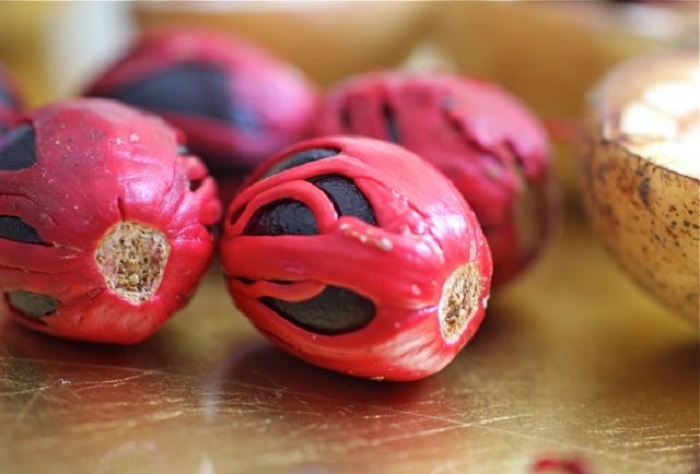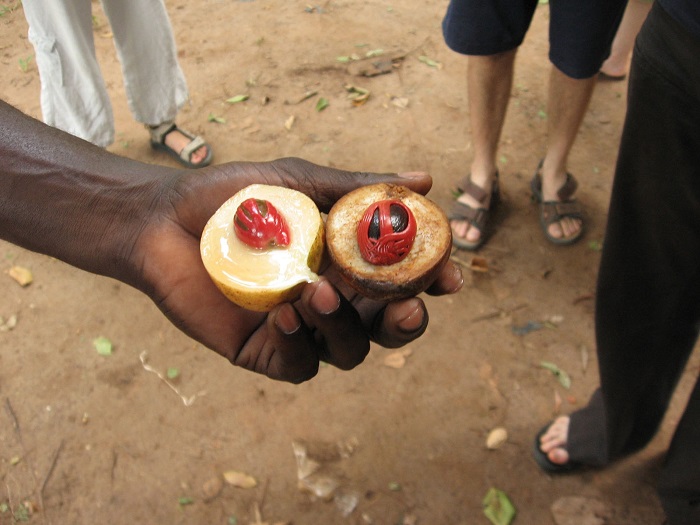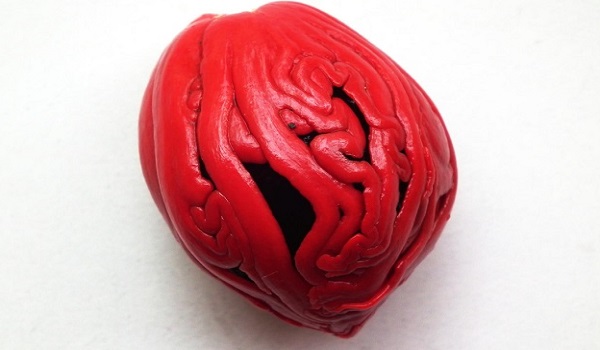Main Name: Mace
Biological Name: Myristica fragrans
Names in Other Languages: Maza (Spanish), Macis (French), Palcát (Czech), Javithri (Hindi), Jathipatri (Tamil, Malayalam), Japathri (Telugu), Jaypatri (Gujarati, Marathi), Jayitri (Bengali & Oriya), Javitri (Punjabi & Urdu)
Biological Name: Myristica fragrans
Names in Other Languages: Maza (Spanish), Macis (French), Palcát (Czech), Javithri (Hindi), Jathipatri (Tamil, Malayalam), Japathri (Telugu), Jaypatri (Gujarati, Marathi), Jayitri (Bengali & Oriya), Javitri (Punjabi & Urdu)
There are several important natural herbs and plants which nature has blessed on mankind. Mace or nutmeg is one of the natural boons. While nutmeg is the actual seed of the tree, mace is the dried reddish covering of the seed. Known for its several culinary and medicinal uses, mace is a prominent flavoring agent in cuisines of most countries. Mace can be used in several forms, either as the dried lacy covering or in powdered form. Its versatile flavor makes it an important ingredient in various dishes to enhance the taste and bring out the color of the food. White sauce, lasagna, stews, ragouts, sausages and pastries are just some delicacies that incorporate mace in their recipes. Mace is highly nutritious and extremely rich in protein and fiber. Besides, there are plenty of health benefits that make mace a significant spice to be stored in the kitchen cabinet. Read further, to acknowledge you with the nutrition facts and advantages to health it has to offer.
History
It is believed that mace originated in Banda, the largest of the Molucca Spice Islands in Indonesia. There are accounts of Roman author Pliny mentioning two flavors of mace around first century AD. It is said that Emperor Henry VI smoked the streets of Rome with mace before his coronation. Around the 6th century, Arabs brought mace to Constantinople. Mace or nutmeg became the matter of massacre and enslavement of the inhabitants of the island of Banda, when the Dutch engaged a bloody war to control the production of mace in the East Indies. The control of mace production remained under Dutch until World War II. The famous Frenchman Pierre Poivre brought mace seedlings to Mauritius where they flourished, eventually ending the Dutch monopoly of the spice. Later, the British East India Company transported the nutmeg tree to Penang, Singapore, India, Sri Lanka, West Indies and Grenada. Today, Indonesia and Grenada are the leading producers and exporters of mace, followed by India, Malaysia, and Sri Lanka.
It is believed that mace originated in Banda, the largest of the Molucca Spice Islands in Indonesia. There are accounts of Roman author Pliny mentioning two flavors of mace around first century AD. It is said that Emperor Henry VI smoked the streets of Rome with mace before his coronation. Around the 6th century, Arabs brought mace to Constantinople. Mace or nutmeg became the matter of massacre and enslavement of the inhabitants of the island of Banda, when the Dutch engaged a bloody war to control the production of mace in the East Indies. The control of mace production remained under Dutch until World War II. The famous Frenchman Pierre Poivre brought mace seedlings to Mauritius where they flourished, eventually ending the Dutch monopoly of the spice. Later, the British East India Company transported the nutmeg tree to Penang, Singapore, India, Sri Lanka, West Indies and Grenada. Today, Indonesia and Grenada are the leading producers and exporters of mace, followed by India, Malaysia, and Sri Lanka.

http://www.marketmanila.com/archives/fresh-mace-nutmeg
Health Benefits of Mace
- Mace oil has great abilities of treating muscular and joint pains and sores as it is an excellent sedative. It also has anti-inflammatory properties and can be very effective for curing arthritis, rheumatism, lumbago, etc. It plays an important role in Chinese medicines for treating abdominal pain and inflammation.
- Mace is very handy for digestion and easing stomach aches and gas from stomach and intestine. Apart from encouraging appetite, it is beneficial for preventing indigestion, flatulence, vomiting and diarrhea.
- Mace oil is a good stimulator as it not only boosts the mind, but also the entire body. Its aromatic properties help in comforting the body and increasing blood circulation.
- Mace contains several essential minerals such as copper, potassium, calcium, manganese, iron, zinc and magnesium. Potassium present in mace is significant for controlling heart rate and blood pressure.
- Mace is rich in manganese and copper which are used by the body as co-factors for the antioxidant enzyme, superoxide dismutase. It contains iron which is essential for red blood cell production and as a co-factor for cytochrome oxidases enzymes.
- Mace is extremely rich in important B-complex vitamins, vitamin C, folic acid, riboflavin, niacin, vitamin A and many flavonoid anti-oxidants like beta carotene and cryptoxanthins. These vitamins and nutrients are necessary for inducing optimum health.
- It is an important ingredient in many cough syrups and cold rubs as it helps in relieving cough and cold. Further, it is very effective in treating asthma.
- Since mace is a great stimulator, it stimulates the brain and eliminates any signs of mental exhaustion and stress. It can improve the quality of dreams, making them more intense and colorful. Mace can be considered as a good remedy for anxiety as well as depression. It enhances concentration and increases the overall efficiency at study and work.
- Mace is antiseptic in nature and is an important ingredient in several toothpastes. It effectively cures toothaches, aching gums, and bad breath.
- Mace is beneficial for treating kidney infections and kidney diseases. Besides, it is known for even dissolving kidney stones.
Mace Nutrition FactsAmount: 1 cup
Weight: 100 g
Weight: 100 g
| Nutrients | Amount |
| Basic Components | |
| Proteins | 6.7 g |
| Water | 8.2 g |
| Ash | 2.2 g |
| Phytosterols | 73 mg |
| Calories | |
| Total Calories | 475 |
| Calories From Carbohydrates | 182 |
| Calories From Fats | 271 |
| Calories From Proteins | 23 |
| Carbohydrates | |
| Total Carbohydrates | 51 g |
| Dietary Fiber | 20 g |
| Fats & Fatty Acids | |
| Total Fat | 32 g |
| Saturated Fat | 9.5 g |
| Monounsaturated Fat | 11 g |
| Polyunsaturated Fat | 4.4 g |
| Omega-3 Fatty Acids | 80 mg |
| Omega-6 Fatty Acids | 4.3 g |
| Vitamins | |
| Vitamin A | 800 IU |
| Vitamin C | 21 mg |
| Thiamin | 312 mcg |
| Riboflavin | 448 mcg |
| Niacin | 1.4 mg |
| Vitamin B6 | 160 mcg |
| Folate | 76 mcg |
| Minerals | |
| Calcium | 252 mg |
| Iron | 14 mg |
| Magnesium | 163 mg |
| Phosphorus | 110 mg |
| Potassium | 463 mg |
| Sodium | 80 mg |
| Zinc | 2.3 mg |
| Copper | 2.5 mg |
| Manganese | 1.5 mg |
| Selenium | 2.7 mcg |

http://boldtgallery.com/places/zambia/peace_corps_pics/zanzibar/spice_tour_nutmeg_and_mace.html
How many calories in mace (per 100 gm)
Mace has about 475 calories per 100 gm its weight.
Mace has about 475 calories per 100 gm its weight.
How to Buy Mace
- Mace is available as whole pieces called ‘blades’ and in powdered form. If possible, always select blades, since powdered mace can be adulterated with other inferior quality mace varieties.
- You can determine the origin of mace through its color. While the orange-yellow blades come from Grenada, the orange-red blades are from Indonesia.
- Always purchase mace in sealed packs from authentic brands from a reputable selling company. Also check the date of package and expiry.
Mace Storage Tips
- Always store the whole mace as well as powder forms in an airtight container.
- When placed in a cool, dark and dry place, it remains fresh and consumable for several months.

